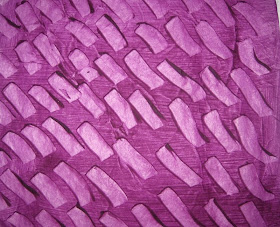Last summer I did some exploration into dyeing with plant materials, but unfortunately I haven't got round to telling you about it! So I'll do a mini-series that I hope will inspire you to try some eco dyeing next summer. It's still deep and dark winter in Finland, but perhaps reminiscing about last summer will make it more bearable until there are more definite signs of spring around.
But wait! You don't have to wait until summer! Perhaps you have something in your cupboard or fridge, or perhaps a potted plant that you might use for this cool technique. You need two sheets of inkjet photo paper, a spray bottle with water, a couple of transparencies (or plastic bags), old newspaper and something heavy, like a stack of books, and of course some form of plant material.
You start by spraying a coat of water on the glossy side of the photo paper (or running the paper under the tap and shaking off the excess). The glossy side is the side that will accept pigment. Put the paper on a protective plastic surface. Then arrange your plant material on the photo paper. Here I've used strawberry caps and crushed tea leaves.
Spray a second sheet of photo paper with water and put it on top of the arrangement, glossy side down. Add another protective sheet of plastic, place the stack between old newspaper, and place some weights on top. Leave it for at least 24 hours, and NO peeking! This is the hardest part of the technique. Then open the layers, rinse off the plant material and let it dry.
Here's the result with
strawberry caps and
tea:
Next, I decided to aim for more colour. I tried
lobelias and
pansies.
And this is the result. Pretty cool! It's interesting how the blue pigment has migrated to the edges, whereas green and yellow form more uniform areas.
Here's a sample with
geraniums and leaves of
silver falls (which didn't leave much of a mark, but more of a resist):
And a close-up. It's like a watercolour painting, isn't it?
And finally,
onion skins, which are a lot easier to get hold of right now:
The results are totally unpredictable and pretty amazing. I feel I want to explore this more: red onion skins, red cabbage, pomegranate peel, berries from the freezer... there must be loads of things to try!
These plant 'photos', by the way, could be fodder for e.g. card-making, scrapbooking or collage, so have a go with it. But I'll have to warn you: it's addictive. Soon you'll run out of photo paper. But, hey, it's a lot cheaper than using the printer. Photo paper gobbles up so much ink, you might as well save your money and use it for this instead. ;-)
Thanks for visiting and see you again soon!
- Annika





























